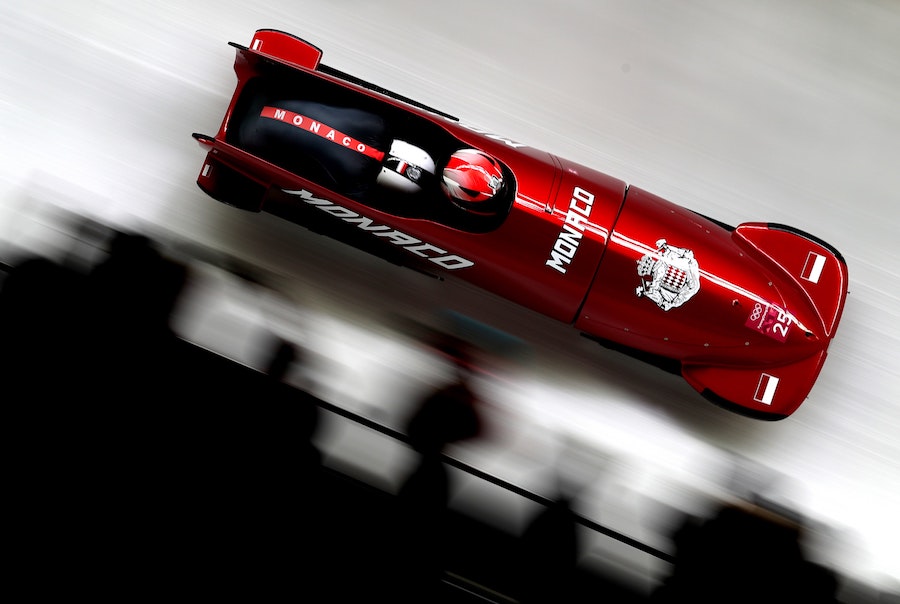Want to try bobsleigh yourself?
Here’s how to get involved and what it does for your fitness
For the last 11 days, our televisions have been dominated by all manner of thrill-seeking, snow-based sports at the Winter Olympics in Pyeongchang, South Korea.
If you’ve been tuning in to all the nail-biting drama, you’ll know that bobsleigh is one of the most terrifying sports of the lot – a high-speed competition that sees teammates tuck themselves into a narrow, gravity-powered vessel and throw themselves down a course of slippery ice and navigate 14-22 tight bends.

Of course, being in a bobsleigh warrants nerves of steel (that much is obvious) but what a lot of people don’t know is that being an Olympic bobsledder involves precisely balancing speed, muscle and weight.
Last night saw Cananda and Germany claim joint gold in the 2-man bobsleigh competition, while today Mica McNeill and Mica Moore are racing for Great Britain in the womens heats.
If you’re brave enough to give the sport a go yourself, here are a few of the fitness benefits you can expect to reap, and where you can safely try it in the UK.
It will build up your overall strength
Bobsledding is a very physical sport that requires a lot of speed and power. The key to bobsleigh is an explosive push start – athletes sprint down the icy track on foot and push their sleigh at speeds of about 40km/h before jumping in. As well has having enough strength to move the sled in the ‘push zone’, drivers must use their core to steer their sleds, by manipulating a pair of ropes connected to the sled’s steel runners.

It’s no easy feat. “We have track guys that try out [bobsleigh] and some of them are good, but they’re not quite powerful enough. We have weightlifters come and try out, but they’re not fast enough. That’s because it’s a hybrid of the sports. We lift three to four times a week, we sprint twice a week, and we push the sled out here twice a week,” US Olympic bobsledder Chris Fogt told The New York Times.
You’ll build up amazing leg power
To prep for an international competition, Olympic bobsleigh teams have to build incredible strength in their legs to be able to get the sled to its highest speeds. “[Bobsleigh] is mostly legwork,” Fogt says. “So we do a lot of squats, a lot of power cleans, jump squats, box jumps, lunges – everything legs.” The upper body stuff, be explains, is just for fun. “If you have huge massive shoulders and a big chest, the wind is hitting you and the sled is slowing down.” This is why bobsledders “don’t do a whole lot of curls, shoulder type work, biceps or chest.”
It’s a great mental release
On the biggest bends in the track, the sleds can reach speeds of up to 80mph and 5G – which is five times the force of gravity. As well as the sheer terror of going as fast as a sports car on a motorway, the G-force can feel like your entire body is compressing – in fact, bobsledders actually wear a “kidney belt” to help protect their organs in transit.

The sensation has been described by some as soaring like a speeding bullet. It’s nerve-shreddingly scary, but what surprisingly attracts many to the sport is the addictive mental benefits. Firstly, there’s the thrill of the adrenaline rush: the exciting, pleasurable effect produced when the adrenal glands dump a large dose of adrenaline into the bloodstream.
Then there’s the dopamine high. Evolution has designed humans with mechanisms to protect us from dangers, but our brain is also equipped with reward mechanisms that are activated when we survive extreme experiences. When you finish a bobsleigh run unscathed, the nerve signal dopamine pleasurably floods the brain in reward, prompting feelings of relief, optimism and happiness – similarly to surviving a bungee jump or skydive.
“There’s not much glamour to it, but I love it because it’s a lot of fun,” says Fogt. “It’s fast and it’s a little bit dangerous.”
Where can I try it out?
The British Bobsleigh and Skeleton Association offer taster sessions for both sports during the summer, giving you the chance to safely try your hand at bobsleigh or skeleton, or both. These two-and-a-half-hour sessions take place at the new and improved push track at the University of Bath, the only track of its kind in the country. The courses offer coaching from current GB athletes, who will show you the tricks of the trade, pass on tips and advice to improve your technique, and answer all your questions on the sport.
Sessions cost £80 per person. To register your interest email [email protected] or call 01225 384343. Visit thebbsa.co.uk for more information.
The Press Association
Latest posts by The Press Association (see all)
- 5 surprising things you can clean in the washing machine - January 9, 2025
- Prince William posted a heartfelt birthday message to ‘most incredible wife and mother’ - January 9, 2025
- Birthday wishes for Catherine from royal family as the Princess of Wales turns 43 - January 9, 2025
- Maple Cinnamon Granola - January 8, 2025
- 8 things your feet can tell you about your health - January 8, 2025





















